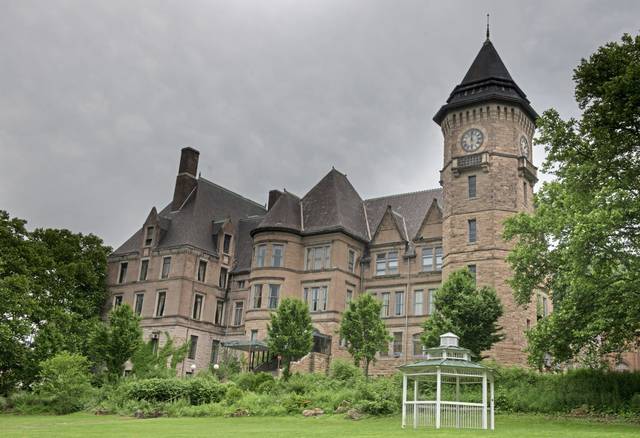William McCloskey: Specter of Westinghouse haunts the 'Castle'
There’s a grand ghost story unfolding with the spirit of old George Westinghouse arising in the little town of Wilmerding as its principal landmark stirs back to life after decades in limbo.
“The Castle,” as it’s been known locally for generations, soon will be reanimated as a specialty hotel of the same name. Officially the Westinghouse Air Brake Co. General Office, the immense, Gothic-looking edifice has commanded the high ground in a park-like setting in Wilmerding since 1890.
The specter of Mr. Westinghouse, the founder, deceased now for 106 years, haunts the place with its faded, formal, businesslike — and yet playful — 19th-century architectural whimsy. Many believe the Castle is fully as eccentric as was Westinghouse himself.
Three of us architectural historians toured the place on a recent dim, wintry afternoon, having been entrusted with the keys by the Castle’s owner, John Graf. We agreed there was a touch of Charles Dickens evident, especially up in the musty attics where the archaic elevator machinery was cradled beneath massive hand-hewn joints that frame the peculiar steep-pitched slate roof.
Designed by the renowned architect Frederick J. Osterling, the building never was a residence but purely a place of business, serving as global headquarters for one of the highest-tech industries of its day. Opened in 1890, damaged by fire, rebuilt and then expanded in the 1920s, the Castle was vacated by Westinghouse Air Brake in 1985. Only a fraction of its 45,000-square-foot expanse has been used since then, by local community interests.
How will Graf make a go of a hotel in Wilmerding, some 14 miles from Downtown Pittsburgh? You can be sure there’s a plan. He’s done this before with great success with both his grand Priory Hotel in the North Side and Mansions on Fifth in Shadyside. The Castle seems a lovely place, when luxury-renovated, as a destination to host large weddings, sales meetings and other high-power gatherings that could readily absorb the travel quirks from the turnpike or Downtown through the peculiar streets and ramps of the Electric Valley.
You also can be sure there’s a plan for the reconfiguring, too, that will keep the best of the original, with its curious ancient details, filigrees and Victorian craftsmanship. We marveled at these throughout the grand executive suites, gorgeous boardroom, and ornate social hall and auditorium. Beyond those obvious configurations, a modern visitor can only guess what the dozens of rooms, nooks and chambers were used for in the day. It’s all too deep in the past to reckon how worldwide business would have been conducted day-to-day in the nineteen-aughts.
Our tour was part of a growing local and national movement to see Westinghouse, the man, restored to prominence as a global scientific and employment innovator. Carelessly, he’s been lumped for generations in popular local lore with Andrew Carnegie, Henry Clay Frick and other Gilded Age industrial titans who amassed phenomenal wealth by exploiting the little guy — never a good idea in the immigrant-rich Pittsburgh region.
Students of the man realize that he was a far more benign, model employer, very much like his next-door Point Breeze neighbor and chum, H.J. Heinz. He is portrayed in the literature of the time as nearly paternalistic in his regard for his employees and their families’ well-being. As well, his three global businesses — Westinghouse Air Brake, Union Switch & Signal and Westinghouse Electric — employed many thousands in good-paying jobs, embracing a sizeable portion of the regional population.
He’s noted for his innovative gender-neutral hiring practices, having employed Bertha Lamme Feicht in 1893 as the first female professional engineer, and workplace policies. He invented the weekend when he established a 5.5-day workweek while other Pittsburgh industrial shops were demanding 6.5 and seven days a week from their workers.
Skilled, specialist work on the renovation, as well as continuing support jobs once the hotel is operating, should provide a measurable boost for the town itself, which grew from just a handful of residents in 1890 to more than 6,400 once Westinghouse Air Brake hit its peak in 1920. Today there are about 2,100 inhabitants.
Interest in the Castle connects spiritually with other pro-Westinghouse initiatives like that being conducted by the Westinghouse Park Second Century Coalition (www.westinghousepark.word press.com), which center on the 10-acre grounds of his Point Breeze mansion, Solitude. It was demolished in accordance with the Westinghouse family’s wishes long ago, but still holds historically significant underground laboratories and workshops that might further illuminate and embellish the inventor’s genius.
William McCloskey, a former Pittsburgh newspaper crime reporter, is a local writer and editor. Contact him at PGHNews.351@gmail.com.
Remove the ads from your TribLIVE reading experience but still support the journalists who create the content with TribLIVE Ad-Free.

